
Privacy statement: Your privacy is very important to Us. Our company promises not to disclose your personal information to any external company with out your explicit permission.
![]() December 31, 2020
December 31, 2020
1 Introduction
With the maturity of SMD LED and through-hole LED technology, LEDs of various colors have been developed like Blue SMD LED, Blue Through-hole LED, Red Smd Led, Red Through-Hole LED, Green Smd LED, green throgh-hole LED ect, and the cost has also dropped significantly. The LED drive circuit with output current above 300mA has an inductive switching power supply and a linear power supply. It is also a combination of a switching power supply and a linear power supply. There is almost no ground bounce and ripple in the linear power drive circuit, and the interference generated by the circuit is small, and it is often used in places where electromagnetic compatibility is required.
The backlight technology of multi-color LED mixed color complementary color is a hot spot of current research. As early as 2000, Japan has produced multi-chip LED backlight products. Subsequently, major companies have introduced high-performance LCDs with multi-chip LEDs as backlights. However, there are few published documents on how to mix and match complementary colors.
Although the red, green and blue color LED Lights are mixed with a wide backlight gamut, there is a red edge phenomenon. In this paper, the white led lamp is used as the main light source, and then the orange light and the blue light are used as the complementary light source. The color temperature of the screen white field is within (6 500±100)K, the color coordinate u' is within 0.198±0.01, and v' is at 0.468. Standard white light within ±0.01.
2, complementary color circuit block diagram
The white light LED uses blue light to excite the phosphor to obtain white light. Since the attenuation of the short-wave component by the liquid crystal screen is greater than the long-wave component, the light emitted by the white light LED is yellowish after being screened out, and it is necessary to supplement the blue light and also make up Red light.
In the case of a typical current of 20 mA, the orange lamp voltage is 2V at normal temperature, the blue lamp voltage is 3V, and the white lamp voltage is 3V.
The three lights are all eight strings. The orange lamp only needs about 16V to work under the typical current condition. The linear constant current source efficiency of the drive circuit is less than 60%. Since the orange lamp is complementary color, the power loss is less than 1W; the linearity of the white light and the blue light. Power efficiency is over 85%.
Each of the three kinds of LED Lamps is driven by a linear constant current source, and the total current is set to 200 mA per channel to ensure that the current of each string of LED lamps is 20 mA of its typical current, as shown in Fig. 1. Each linear constant current source independently uses PWM dimming signals of the same frequency, their frequencies are fixed, and the duty time varies with the dimming brightness.
Using FPGA as the controller, adjust the PWM duty ratio according to the dimming command of the host computer to control the brightness of the backlight; sample the data of the color sensor, fine-tune the PWM duty ratio of the orange and blue lights, and ensure that the color temperature does not change when the temperature changes. change.

3, PWM dimming and complementary color
3.1 Preparations for orange and blue light supplementation

Figure 2 shows the PWM dimming waveform of the white and complementary color lamps. The drive circuit should be guaranteed to meet the following conditions:
(1) The driving voltage should be able to ensure the voltage output necessary for the constant current of the LED lamp; (2) The output current of the driving circuit should have the consistency of the on-time, so that the brightness can be linearly adjusted; (3) in the 昼 mode Under the white light should gradually increase, and the complementary blue and orange lights should gradually increase according to the proportion of white light changes.
Figure 2 PWM dimming waveform of white light and complementary color light.
3.2 Mixing light on SS-230 flat panel display system integrated analysis instrument
Figure 3 is a photograph of the SS-230 flat panel display integrated analysis system. During the experiment, the white light was changed from low to high brightness, and the orange and blue lights were gradually increased in proportion, ensuring that the color temperature was (6 500 ± 30) K and the color coordinates u' = 198, v' = 0.468. Recording data from the low-brightness to high-brightness dimming process, white light, orange light, and blue light dimming PWM waveform high-level duration, a total of 40 sets of data were recorded.

Figure 3 SS-230 flat panel display integrated analysis system.
3.3 Data fitting
According to the recorded 40 sets of data, the dimming PWM high time of the three lamps can be obtained under different brightness conditions. The relationship between the dimming high level time and the brightness of the three kinds of light is fitted below, as shown in Fig. 4.
The expressions of the three uninterrupted curves in Figure 3 are as follows:
image 3

Figure 4 shows the relationship between brightness and the number of dimming levels of the three lamps.
In equation (1), L is the brightness, W, O, and B are the high-level time series of the white, orange, and blue PWM waveforms, the dimming period is 500μs, and the high-level time series is (7FFF)16. = (32 767) level 10.
3.4 color closed loop control
Based on the resulting fit curve, a standard white light source can be obtained by dimming over the full brightness range with the backlight temperature being constant and consistent with the backlight temperature at which the curve is fitted. However, it is impossible to ensure that the temperature of the backlight LED lamp is constant. As the temperature of the LED lamp changes, the attenuation of the white light, the orange light and the blue light are different, and the color temperature may drift.
The number of pulses output by the red, green and blue 3 color components of the color sensor in 200 dimming cycles, ie 100 ms, is recorded, and these data are used as the luminance values of the 3 color components.
When the temperature changes, according to the red, green and blue brightness data measured by the color sensor, fine-tune the PWM waveform of the orange and blue lights for a high time, so that the red, green and blue brightness ratios are constant, then the color temperature is maintained. constant.
4 Conclusion
On the SS-230 flat panel display system comprehensive analysis instrument, 40 points were measured from low brightness to high brightness change, and the PWM pulse high time of the three types of lamps was adjusted to obtain a standard white light source. Then, the linear fitting method is used to obtain the proportional relationship of the high-level duration of the PWM waveforms of the three lamps under different brightness conditions. According to this relationship, the dimming can ensure that the backlight is standard white light in the entire brightness range. According to the red, green and blue 3 color channel data output by the color sensor, the PWM high time of the orange and blue lights is fine-tuned, and the color temperature is kept constant while maintaining the proportional relationship of the red, green and blue 3 color channel data. Using the above method, the white color temperature of the screen white field is within (6 500±100)K, the color coordinate u' is within 0.198±0.01, and the standard white light with v' is within 0.468±0.01.
The above is the Backlight with multi-color LED complementary color SMD LED and through-hole LED type we have listed for you. You can submit the following form to obtain more industry information we provide for you.
You can visit our website or contact us, and we will provide the latest consultation and solutions
Send Inquiry
Most Popular
lastest New
Related Products
Send Inquiry
Tel: 86-0755-89752405
Whatsapp: +8615815584344
Address: No.3, Lida alley, Qiuwu community, Longgang District, Shenzhen, Guangdong, China. 518116, Shenzhen, Guangdong China
Website: https://www.bestsmd.com

Privacy statement: Your privacy is very important to Us. Our company promises not to disclose your personal information to any external company with out your explicit permission.

Fill in more information so that we can get in touch with you faster
Privacy statement: Your privacy is very important to Us. Our company promises not to disclose your personal information to any external company with out your explicit permission.